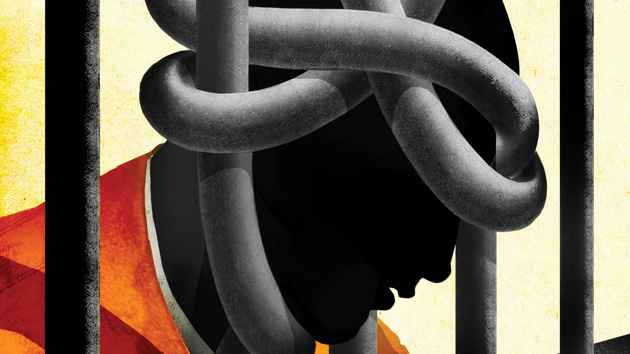
David J. Phillip/AP
Stanley Griffin was deemed intellectually disabled when he was 16. He scored an abysmal 65 on an IQ test, which put him among the lowest 1 percent of Americans in terms of his intellectual capacity. (An average score is 100.) He was spelling and doing math on a third-grade level. His school designated him mentally retarded and put him in special ed. He even competed in the Special Olympics.
As Griffin grew older, he had trouble finding and holding any job. It took him seven tries to finally pass the test required to drive a semi truck, and when no one would hire him even then, he resorted to manual labor. But his contractor brother wouldn’t let Griffin use power tools because he couldn’t manage them properly; Griffin was oblivious to danger, too, and would walk dangerously close to the backhoe. He tried, and failed, to master simple plumbing—even a Denny’s application proved overwhelming. His mental deficiencies left him unable to live alone, pay bills, or even purchase his own clothing because he would get so flummoxed by the math.
Somewhere along the way, Griffin began getting into trouble and having run-ins with the law. In 1990, at age 25, he was tried and convicted for burglary and aggravated assault with a deadly weapon, and sentenced to 20 years in prison. He served 12, but things only went downhill after his release. He ended up homeless, and finally, in 2012, Griffin was convicted of strangling to death 29-year-old Jennifer Hailey in College Station, Texas, and violently assaulting her nine-year-old son, who had witnessed her murder. He was tried and found guilty. The prosecutor asked for the death penalty, and the jury obliged.
There is little question Griffin should have been locked away. At the same time, he should never have been a candidate for the death penalty. The Supreme Court has twice ruled that it is unconstitutional to execute people who are intellectually disabled—a polite alternative to “mentally retarded”—regardless of the nature of their crimes. Their “diminished capacities,” the court further noted, made such defendants far less likely to be deterred by the threat of death, which is one of the few remaining justifications for capital punishment.
Intellectual disability is just one of several mitigating factors that, at least in theory, are supposed to spare people from execution. The death penalty, the Supreme Court has noted, is intended for the worst of the worst—offenders more depraved than your average murderer, who have what the courts call “extreme culpability.”
This is precisely why capital trials have a separate sentencing phase. At this trial within a trial, jurors are asked to weigh evidence that might counterbalance the heinousness of the crime, in particular intellectual disability, severe mental illness, horrific trauma, and simply youth—the Supreme Court in 2005 imposed a blanket ban on the execution of anyone who was under 18 at the time of his crime—before deciding whether to impose the ultimate penalty. In the sentencing phase for Boston Marathon bomber Dzhokhar Tsarnaev, for example, his lawyers argued that he was essentially just a kid in the thrall of his charismatic ringleader brother.
This setup was meant to ensure the American ideal of individualized punishment—that the consequences suit the particular circumstances of the case. And yet death row is crowded with people whose cases include several of these mitigating factors. (See sidebar, “Put Yourself in the Jury Box. Did These 8 Men Deserve to Die?“)
The authors of a study published last year in the Hastings Law Journal took a closer look at the most recent 100 executions (as of June 2013) to determine whether any of those defendants might have been spared in accordance with the law. As it turned out, the overwhelming majority met one or more of the criteria: One-third of the executed prisoners had a documented intellectual disability, borderline intellectual functioning, or a traumatic brain injury—and eight scored below 70 on an IQ test, a level of disability that should exempt a defendant from execution. Four were 18 at the time of their crimes.
Although the Supreme Court has twice ruled that states may not execute someone who is insane, 54 of the 100 executions studied involved prisoners who showed symptoms of severe mental illness, including six cases of schizophrenia, three of bipolar disorder, and eight of PTSD. Six had tried to kill themselves at least once.
Fully half of the condemned prisoners had histories of severe childhood trauma. Some had witnessed the murders of loved ones. One had shot his father to protect his mother from the man’s brutal abuse. Another man’s violent history even traced all the way back to Pancho Villa, whose bandits had killed his great-grandfather and kidnapped his grandfather during the Mexican revolution. The files are full of stories about men who were fed alcohol as toddlers, beaten brutally as children, shot at by stepfathers, abandoned by psychotic or drug-addicted parents, sexually abused—in some cases raped and sodomized—by parents and neighbors and caretakers. One teen was forcibly circumcised by a sadistic group-home leader and gang-raped by the others. The details of these cases make for painful reading, but they go a long way toward helping explain what makes someone a killer.
After taking all of the evidence into account, the Hastings authors concluded that just 13 of the 100 people executed met the legal definition of “extreme culpability.” Why, then, were the other 87 sentenced to death and ultimately killed by the state?
One of the primary explanations for errant executions is simply bad lawyering. Judges have let a surprising number of capital defendants represent themselves at trial—an almost certain ticket to death row. But even with a court-appointed lawyer, the quality of the representation is, more often than not, pretty horrendous. And to later prove that a lawyer’s ineffective counsel led to a death penalty, well, the bar is extremely high.
Local courts have handed complex death penalty cases to attorneys who have never defended one. Defense lawyers have slept through portions of a client’s capital trial, been drunk on the job (see this extreme case), missed critical deadlines, and otherwise proved incompetent. And whether due to laziness or incompetence or ridiculous caseloads or a combination of those things, all too many defenders fail to adequately scour a client’s past for details that might persuade a juror to show mercy.
As a result, the mitigating details often don’t get presented until far along in the appeals process. “But then it’s too damn late,” says Robert Smith, an assistant law professor at the University of North Carolina-Chapel Hill and coauthor of the Hastings Law Journal article. (Consider the case of Cecil Clayton, a prisoner recently executed by the state of Missouri, never mind that he was actually missing part of his brain.) The best time to keep someone off death row is before he’s sentenced—if not earlier. “If you build a good mitigation case, you don’t go to trial,” Smith notes.
Which is not to say it’s a slam dunk. Far from it. Raising mitigating evidence at trial can be a dicey business. The problem, says Maurie Levin, a veteran death penalty attorney, is that juries (and many lawyers) believe “the choice between life and death is only about the crime.” Mitigation evidence is about “who this person is, that there’s a capacity for empathy, and any reason for the jury to think that this person is not the worst of the worst,” Levin says. “The true concept of mitigation has to be separated out from questions of culpability or explaining the crime.”
Virtually the only question truly at issue in the trial of Dzhokhar Tsarnaev, who was found guilty on all counts, is whether he deserves to die. If the prosecutor hadn’t been so keen on pushing for the death penalty, Tsarnaev would likely have accepted a plea of life without parole in a Colorado supermax. But because the case went to trial, the defense strategy became all about humanizing him and convincing jurors he was just along for the ride with his brother.
But juries sometimes hear mitigating evidence and conclude that it makes the death penalty more appropriate, not less. For example, in the case that led the Supreme Court to ban the death penalty for juveniles, the trial prosecutor had argued that Christopher Simmons, who was 17 at the time of his crime, was a prime candidate for death precisely because he was young. “Think about age,” he told the jury. “Seventeen years old. Isn’t that scary? Doesn’t that scare you? Mitigating? Quite the contrary, I submit. Quite the contrary.”
This double-edged sword is particularly sharp in cases involving mental illness. Decades of research show that when a capital defendant pleads not guilty by reason of insanity and is subsequently found guilty, he is far more likely to get a death sentence. In an essay on the subject, Christopher Slobogin, a law professor at Vanderbilt University, referenced a study showing that a failed insanity defense is an even better predictor of whether someone will be sentenced to death than whether the defendant had a criminal history or had committed another crime alongside the killing. “Research shows that people think an insanity defense is for malingerers,” Slobogin told me.
Jurors, he says, also tend to view mentally ill defendants as scarier than sane criminals—which makes them more likely to vote for death. This is perhaps one reason the insanity defense is so rarely invoked. One large study across eight states found that just 1 percent of felony defendants used it—and only about 1 in 4 of them succeeded.
Many states don’t even allow the insanity defense these days—four have abolished it, and others have changed the sentencing option from “not guilty by reason of insanity” to “guilty but insane.” The latter, Slobogin says, is an attempt to discourage the notion that a person can escape responsibility for their actions on account of severe mental illness.
Without the insanity option, legal scholars have argued, mentally ill defendants may be more likely to land on death row, where the ACLU estimates that up to 10 percent of the residents struggle with severe mental illness. A “guilty but mentally ill” plea certainly didn’t do much for James McVay, a South Dakota man sentenced to death last May for killing a woman as part of his delusional plan to assassinate President Obama. He hanged himself in his cell about four months later.
While the legal definition of insanity is a narrow one, the Supreme Court has made a categorical exemption for people with intellectual disabilities. If a criminal has an IQ of around 70 or less, particularly when that disability was apparent since he was a kid, he isn’t supposed to be sentenced to death in the first place. But defendants like Stanley Griffin routinely end up on death row anyway. Slobogin suggests this is partially because the high court let states choose how to implement its rulings, and some states employ procedural roadblocks that make it almost impossible for a defendant’s lawyers to prove he is intellectually disabled.
Among other procedural hurdles, some states make defendants wait until the sentencing phase of the trial to raise claims of intellectual disability. That’s problematic, because a juror may use details from the guilt-or-innocence phase—about the planning of a crime, for instance—to draw conclusions about the defendant’s mental fitness before all of the evidence is presented. The Supreme Court doesn’t seem too inclined to fix the problem, in any case. Justice Scalia indicated as much this past week, when he said he didn’t plan on reading the voluminous trial record in a case before the court on precisely this issue.
Making matters worse, research suggests that jurors expect people with low IQs to come across as more impaired—think Sean Penn in the movie I Am Sam—than they often do. So when a mentally disabled defendant appears relatively normal, jurors may be disinclined to believe the evidence.
Beyond abolishing capital punishment, there is one reform that’s been proven to help defendants with strong mitigating factors avoid death row: providing them with experienced, decently paid lawyers. Consider what happened in Virginia recently. Back in 1998, juries there handed down nine death sentences, but in four of the past five years, they handed down zero. What changed?
Virginia was once infamous for having some of the country’s worst capital defense lawyers—little surprise, since the courts only paid them about $13 an hour. In 2003, though, state officials set up regional offices to provide capital defendants with meaningful representation.
The move came not long after Virginia’s governor was forced to pardon Earl Washington, a man with an IQ of 69, who had spent 17 years on death row for a crime he didn’t commit. The state was ordered to pay Washington nearly $2 million in compensation—about what it would cost to fund the capital defense offices for a year.
The new offices are staffed with specialized lawyers, mitigation experts, and investigators tasked with digging up the sort of information that can help keep people off death row. The state Supreme Court predicted that they would end up saving Virginia about $2.8 million a year. Indeed, the number of new death sentences dropped from six to two in a single year, and has not exceeded that since.
Only eight people remain on Virginia’s death row today. It’s a sign that the state may finally be on track to execute only the worst of the worst, thus respecting the constitutional imperative that the ultimate punishment is reserved for the rare case that truly warrants it.
















